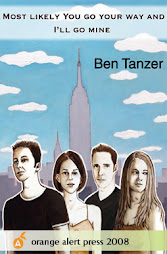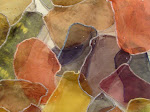
Curtis Smith
"There's heartbreak between sound and noise, the place where we are our only audience. The canvases we paint, the songs we sing, the ways we try to love one another - our days are full of the sounds we make. But the world is awash in sounds unappreciated, sounds that never have the luxury of becoming noise." from Sound + Noise
The space between sound and noise could be translated to the space between thought and action or dream and reality. It is the difference between speaking and being heard. If you are speaking to someone or thinking of someone and they cannot hear or think about you did you actually speak? As thoughts and sounds pile-up, we amass a memory, or what Pennsylvania writer Curtis Smith may call a "ghost life". As we pass images throughout the day they become part of this ghost life, a place where we go to recall moments in time, friends, family, whatever we have stored.
Part of Curtis' new novel, Sound + Noise, is about trying to capture images, memories, ghosts, before they fall away, and part of it is about moving forward. Unsure if you really understand the past, but afraid if you don't move the future will be lost. It is a story about love, loss, memory, and taking that leap. Sound + Noise is being published by Casperian Books on Sept 2nd.
Recently, Curtis was kind enough to answer a few of my questions.
Orange Alert (OA): You latest novel, Sound + Noise, will be released by Casperian Books on Sept. 2nd. What can you tell us about your novel?
Curtis Smith (CS): I guess at its core, Sound and Noise is a love story. At least that's what its structure suggests. I feel more drawn to other aspects it touches upon, especially its investigations of art and faith and the places we make for them in our lives. It's a rather quiet book, a character-driven story of two decent people trying to do the right thing in a difficult situation. Part of it touches on the national debate sparked by the Terri Schiavo case, the question of what exactly makes us human, but that's just part of the narrative background, and it's not an issue I make any judgments about. The real focus is on the lives that are left behind in such a case. The book was written long before the Schiavo case--it was at another publisher for almost two years before they folded. I was fortunate to turn around after that and find such a wonderful publisher who believed so strongly in the novel and its potential.
OA: I enjoyed the reoccurring imagery that you would use to emphasize various situations in the book. The image of the high driver, or the image of being naked, or the image of Ethel Merman, they are have their own meaning and may have different meaning for each reader. Why did you select these images for Sound + Noise?
CS: I'm very drawn to reoccurring images--I love the way they resonate and accumulate meanings and nuances and how they evolve as a story progresses. I view them as little imagistic threads that add to the fabric of the novel. As far as my writing technique goes, I'm a thorough planner. I block out scenes and chapters long before I put pen to paper to start my first draft. Some of these reoccurring images are planned as well, but most arise organically as I'm writing the story. Some wither and are cast off before the final draft, but some blossom, and when they do, I'm free to plant the seeds throughout the pages wherever it helps the cause. I think the high diver and naked images work to the same end--an individual's feelings of vulnerability, isolation and fragility. Ethel Merman occupies the opposite end of that spectrum--she's the one who puts on the stage smile and lets loose with the show-must-go-on bravado that's sometimes necessary when times get tough.
OA: The cover of the book is by artist Eric Zener, and it really fits well with the book. How did you find Eric's work, and how much input did you have the cover decisions?
CS: I first saw Eric's work on the cover of an issue of West Branch a few years ago, and as we were going through discussions about the cover for Sound and Noise, I remembered Eric's work. I hunted him down on-line, and when I saw his painting "Out on the Edge," I thought it might be a great fit for the cover. I sent an email and we had some discussions and worked out a deal to use it. I'm thrilled to have such a beautiful piece of art to adorn the book's cover.
OA: You have a collection of essays coming out with Sunnyoutside. What can you tell us about that collection and your experience so far with Sunnyoutside?
CS: I'm relatively new to writing nonfiction. It's a very interesting form that I really enjoy. I wrote my first essay about three or four years ago, and in the time since, I've been fortunate to have a dozen or so pieces published, many of which focus on questions that have come to light since I became a father. My head is swimming with ideas for stories, but nonfiction is much, much more difficult for me to organize into a pleasing flow. But once an essay comes together, it has a certain truth, a certain finality that leaves a more fulfilling impression (at least to the me, as the writer) than fiction.
I wasn't really shopping my nonfiction collection around, but then I bought Rusty Barne's book, Breaking Down the Bones. Not only did I enjoy the stories, but I also thought the book was very handsome--and its length made me think Sunnyoutside might be a publisher who'd consider a nonfiction manuscript of a similar length. They've been great to deal with--and I'm looking forward to seeing the project through.
OA: Do you find you write differently when you know a story will be published in print as opposed to on-line? Do you feel printed work is more legitimate than on-line work?
CS: I started publishing stories in the early 90's, so I'm one of those folks who knew only print first, and as such, I'm partial to print and the whole tactile aesthetic of holding a book. And another thing on-line has going against it, at least in my head, is that to me, the computer screen translates into work--either real, paycheck-generating work or the work of my writing. Reading with a book in my lap brings notions of relaxation and quiet and intellectual investment, all precious commodities in my life.
That said, I've been warming up to the whole on-line world. I've been fortunate to publish on-line with a number of very cool sites, and there are some wonderful journals with superb writing that I'd love to contribute to in the future. What on-line lacks in the aesthetic realm, it more than makes up for in accessibility. The other year, I had a short piece on Pindeldyboz and a few months later, I received an email from a literary journal in India asking if they could reprint the story. That's pretty cool, I think, and it's something that probably wouldn't happen with a print journal.
OA: What's next for Curtis Smith?
CS: I hope to do a number of readings and appearances and such to promote both Sound and Noise and The Agnostic's Prayer (the essay collection from Sunnyoutside). I also just signed on with Press 53 to do my next story collection in 2010. They did my last collection, The Species Crown, and I'm really looking forward to working with them again. Other than that, I'll just keep stealing away whatever nuggets of time I can to sit down and work on the next project that grabs my attention.
Bonus Questions:
OA: The seems to be one in every town (or at least there used to be) what is the coolest indie bookstore in your area?
CS: Most of the bookstores I've loved are gone. But the Ardmore Paperback Bookstore on Lancaster Avenue in Ardmore, PA is a place I grew up loving and which still exists. I did a reading in Philly recently and stopped by the store. It's small by current standards, but it brought back a ton of memories of saving up to go there to buy a book by Bradbury or Vonnegut. When I was there last, I even bought a few books for old time's sake.
OA: What type of music do you enjoy? Who are a few of your favorites?
CS: I like all types of music--I love jazz, especially the post WW2 through Bitches Brew era. I've always been a big Stones fan. Wilco and Radiohead are some of my current favorites. Last year, I saw Dylan for the first time. I've seen a lot of shows over the years, but that was special. We had great seats and I kept thinking, 'That's Bob Dylan right in front of me.' I was absolutely star-struck. It was a pretty cool feeling to be in your late forties and still be overcome by that kind of admiration.
For more information on Curtis Smith you can visit his
website, and to pre-order a copy of Sound + Noise visit
Casperian Books.

+by+Nick+Volkert).jpg)





























 The Mojomatics
The Mojomatics


















